Top 12 Corrosion Engineer Skills to Put on Your Resume
In the highly specialized field of corrosion engineering, showcasing the right set of skills on your resume can sharpen your edge and lift your odds of landing interviews. The twelve skills below anchor modern practice. They signal competence, readiness, and a steady hand when infrastructure meets harsh, unforgiving environments.
Corrosion Engineer Skills
- Cathodic Protection
- Corrosion Monitoring
- AMPP Standards (formerly NACE)
- Electrochemistry
- Material Selection
- Protective Coatings
- Failure Analysis
- Welding Inspection
- API Standards
- Corrosion Inhibitors
- Risk Assessment
- Pipeline Integrity
1. Cathodic Protection
Cathodic protection controls metal corrosion by shifting the metal surface to a cathodic state within an electrochemical cell. Do it with sacrificial anodes that give themselves up first, or with impressed current systems that push protective current where it’s needed.
Why It's Important
It slashes corrosion rates and preserves structural integrity in buried, submerged, or otherwise conductive environments. Longer life. Fewer leaks. Calmer maintenance budgets.
How to Improve Cathodic Protection Skills
Measure what matters: Perform routine potential surveys, coupon checks, and current balance reviews. Validate against applicable criteria and adjust without delay.
Pick the right anodes: Select materials and configurations (distributed, deep well, bracelet, sled) to deliver uniform current. Poor placement equals patchy protection.
Mind continuity: Ensure bonds and joints conduct as intended. Verify isolation devices, track stray currents, and fix interference at the source.
Tune ICCP systems: Set rectifiers thoughtfully, record trends, and use remote monitoring to catch drift early. Seasonal changes happen—follow them.
Maintain ruthlessly: Replace spent anodes, service rectifiers, clean test stations, and audit data quality. Small lapses snowball.
Use modern tools: Deploy remote telemetry, data analytics, and GIS to optimize coverage and planning.
Follow standards and keep learning: Align with AMPP guidance and keep skills current with formal training and field practice.
How to Display Cathodic Protection Skills on Your Resume
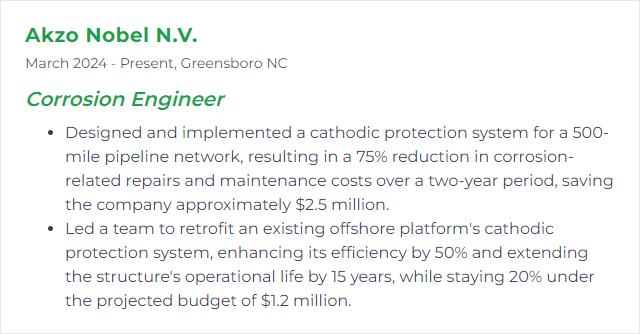
2. Corrosion Monitoring
Corrosion monitoring tracks degradation rates and conditions using probes, coupons, inspection data, and analytics. Spot problems early, anticipate the next move, act before failure.
Why It's Important
Early detection prevents costly surprises, improves safety, and drives smarter maintenance. Data turns guesswork into decisions.
How to Improve Corrosion Monitoring Skills
Use the right sensors: ER, LPR, ECN, and hydrogen probes each tell a different truth. Mix methods to see the full picture.
Blend with NDT: Ultrasonic thickness, radiography, eddy current, and MFL reveal damage without tearing things apart.
Go predictive: Pair historical and real-time data with models or machine learning to forecast risk and prioritize intervention.
Calibrate and verify: Instruments drift. Procedures drift too. Tight calibration and clear procedures keep data trustworthy.
Deploy coupons and probes well: Place them where flow, temperature, chemistry, and phase represent reality. Validate exposure time.
Train the team: Good data collection and interpretation hinge on sharp people and shared methods.
How to Display Corrosion Monitoring Skills on Your Resume
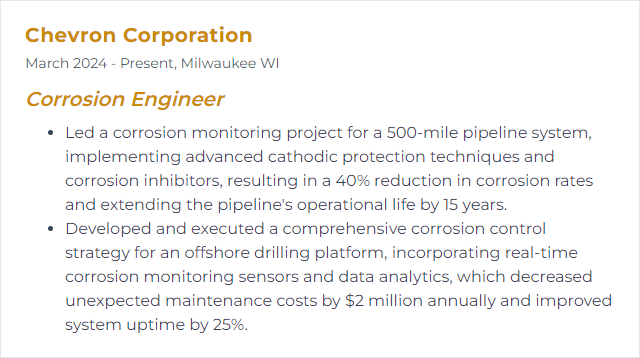
3. AMPP Standards (formerly NACE)
AMPP standards (from the merger of NACE International and SSPC) define consensus best practices for corrosion control, materials protection, inspection, and coatings. They keep projects aligned, auditable, and safe across industries.
Why It's Important
Standards translate experience into repeatable results. They reduce ambiguity, guide design and operations, and underpin compliance.
How to Improve AMPP Standards Skills
Stay current: Track revisions and technical bulletins. New materials and methods arrive fast.
Spot gaps: Where field realities outpace documents, document the need and evidence for updates.
Bring data: Case histories, lab work, and field trials turn anecdotes into change.
Join the work: Participate in technical committees and ballots. Consensus is built, not wished for.
Educate and implement: After adoption, create training, checklists, and audits to drive consistent application.
Review performance: Monitor outcomes, gather feedback, and iterate again. Standards live or they lag.
How to Display AMPP Standards Skills on Your Resume
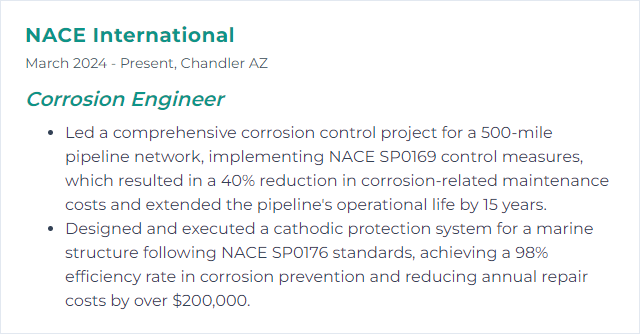
4. Electrochemistry
Electrochemistry links electricity with chemical change. In corrosion, it explains anodes, cathodes, potentials, kinetics, and the subtle chemistry that eats metal—and how to stop it.
Why It's Important
It’s the foundation beneath corrosion mechanisms and control. Understand the reactions, and you can predict behavior, design protection, and troubleshoot with confidence.
How to Improve Electrochemistry Skills
Rebuild fundamentals: Electrode potentials, Nernst, Butler–Volmer, polarization. Master the language.
Connect to mechanisms: Galvanic couples, crevices, pits, SCC—tie each failure mode to its electrochemical roots.
Practice measurement: EIS, polarization scans, and potentiodynamic tests can illuminate rate and mechanism when done right.
Model thoughtfully: Use simulation tools to test scenarios and protection strategies before field trials.
Read and discuss: Follow journals and professional societies. Debate sharpens judgment.
How to Display Electrochemistry Skills on Your Resume
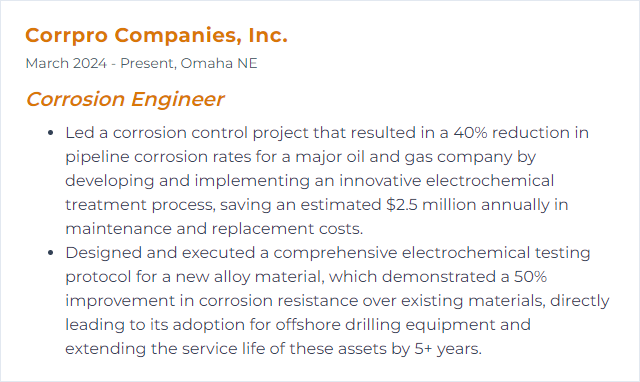
5. Material Selection
Material selection chooses alloys, polymers, composites, and linings that endure the actual service environment—chemistry, temperature, pressure, stress, and time—while meeting cost and performance targets.
Why It's Important
Pick the right material and corrosion becomes manageable. Pick poorly and failure is scheduled.
How to Improve Material Selection Skills
Characterize the environment: Identify species, contaminants, phases, velocities, temperatures, and transients. Reality beats assumptions.
Map required properties: Corrosion resistance, strength, toughness, weldability, thermal limits, cleanliness—rank by importance.
Use standards and data: Reference ASTM and ISO material and test standards. Compare credible data, not marketing gloss.
Consider whole-life cost: Include maintenance, inspection, downtime, and replacement, not just purchase price.
Prototype and test: Lab exposure and field trials reveal surprises early. Validate assumptions.
Collaborate early: Work with design, operations, and suppliers to surface constraints you can’t see from a desk.
How to Display Material Selection Skills on Your Resume
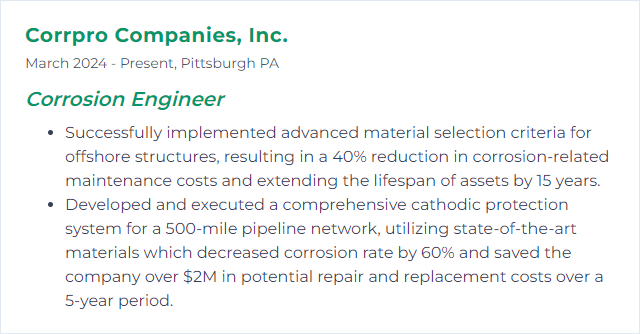
6. Protective Coatings
Protective coatings form barriers against moisture, ions, chemicals, and wear. They buy time, block reactions, and keep structures sound.
Why It's Important
Coatings can be the most economical shield against corrosion, often the first line of defense and the easiest to maintain—if applied and inspected properly.
How to Improve Protective Coatings Skills
Start with surface prep: Cleanliness and profile determine adhesion. The coating system can’t rescue a bad surface.
Choose systems for service: Match resin chemistry and build (zinc-rich primers, epoxies, polysiloxanes, urethanes) to environment and temperature.
Control application: Verify film thickness, environmental conditions, cure, and recoat windows. Document everything.
Consider advanced options: High-solids, waterborne, powder, or smart/self-healing systems where justified. Reduce VOCs and meet regulatory needs.
Inspect and monitor: Holiday detection, adhesion testing, pull-off testing, and periodic surveys catch degradation early.
Follow AMPP practices: With SSPC content integrated into AMPP, use current guidance for selection, application, and inspection.
How to Display Protective Coatings Skills on Your Resume

7. Failure Analysis
Failure analysis unpacks how and why components degrade or break. It blends materials science, fracture mechanics, electrochemistry, and service history to prevent a repeat.
Why It's Important
Root cause clarity turns costly failures into durable fixes. It guides design tweaks, material changes, and protective measures that stick.
How to Improve Failure Analysis Skills
Collect the story: Environment, duty cycle, transients, maintenance history—context matters as much as the fracture face.
Use the right tools: Visual inspection, metallography, SEM/EDS, hardness, fractography, chemical analysis. Build evidence, don’t cherry-pick.
Classify mechanisms: Differentiate uniform corrosion, pitting, galvanic attack, MIC, erosion-corrosion, SCC, hydrogen damage.
Test hypotheses: Recreate conditions in the lab when feasible. Validate with data, not hunches.
Close the loop: Recommend targeted changes—materials, coatings, CP, design geometry, operating windows—and verify effectiveness after implementation.
Document rigorously: Clear reports with photos, micrographs, and timelines build trust and drive action.
How to Display Failure Analysis Skills on Your Resume
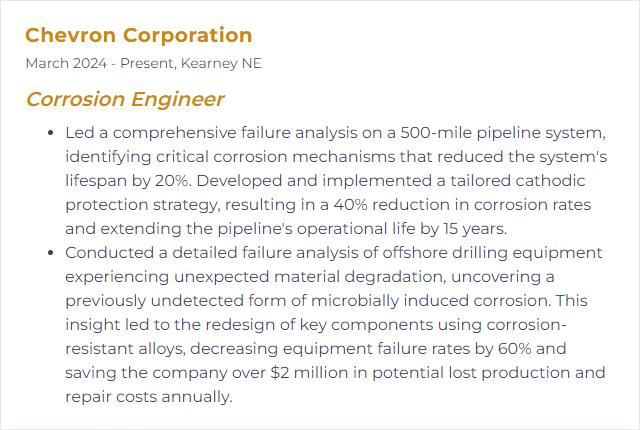
8. Welding Inspection
Welding inspection verifies that welds meet integrity requirements and resist corrosion in service. It spans procedure qualification, welder performance, fit-up, and in-process and in-service examinations.
Why It's Important
Welds are common weak points. Catching defects and discontinuities early prevents leaks, cracking, and premature corrosion.
How to Improve Welding Inspection Skills
Know the processes: SMAW, GTAW, GMAW, FCAW, SAW—each carries different defect signatures and corrosion risks.
Build certification and practice: Training through AWS, ASNT, and AMPP strengthens method selection and execution.
Leverage advanced NDT: PAUT, TOFD, radiography, eddy current, and UT help characterize flaws beyond surface level.
Focus on metallurgy: Heat-affected zones, sensitization, hardness, and residual stress drive corrosion mechanisms like SCC and HIC.
Specify mitigation: Post-weld heat treatment, consumable selection, coatings, and CP integration reduce future damage.
Plan recurring checks: Risk-based inspection schedules keep eyes on the right locations at the right time.
How to Display Welding Inspection Skills on Your Resume
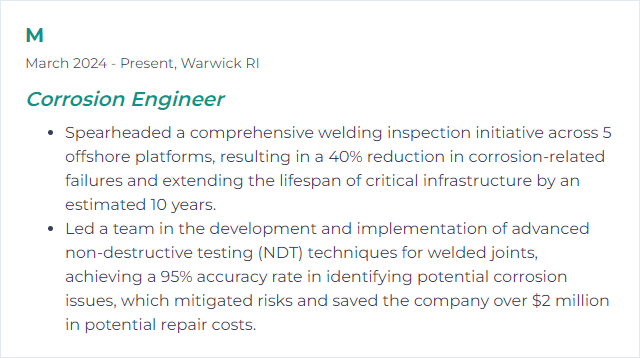
9. API Standards
API standards guide design, operation, inspection, and maintenance across oil and gas assets. For corrosion engineers, they frame material selection, corrosion control, RBI, and integrity management practices.
Why It's Important
They embed proven methods into everyday work, harmonize expectations across stakeholders, and protect people and assets.
How to Improve API Standards Skills
Study and apply: Know which documents govern your equipment class and environment. Implement them consistently.
Contribute field lessons: Feed real-world performance data and case studies back into committee work to drive practical updates.
Adopt new tech wisely: Digital monitoring, data analytics, and IOT sensors can enhance inspection and mitigation programs when integrated into API-aligned processes.
Champion sustainability: Favor corrosion control solutions that reduce waste, emissions, and rework while meeting safety and reliability targets.
Close feedback loops: Audit application quality, measure outcomes, and recommend revisions supported by evidence.
How to Display API Standards Skills on Your Resume

10. Corrosion Inhibitors
Corrosion inhibitors are chemicals that slow or halt metal attack by forming protective films, altering interfacial reactions, or removing aggressive species. A precise fit to chemistry and conditions makes all the difference.
Why It's Important
They extend equipment life and cut downtime, especially in systems where coatings or CP aren’t feasible or sufficient on their own.
How to Improve Corrosion Inhibitors Skills
Match inhibitor to system: Account for metallurgy, phase behavior, temperature, flow, and contaminants. One-size-fits-none.
Exploit synergy: Blends of organic and inorganic inhibitors can reduce dosage while boosting protection.
Go greener when possible: Favor lower-toxicity, biodegradable choices where performance and regulations allow.
Use smart delivery: Encapsulation, controlled release, and triggered systems sustain protection through upsets.
Monitor and optimize: Verify with probes, coupons, iron counts, and residual measurements. Tune dosage to conditions, not habit.
Validate with testing: Lab screening and field pilots reduce surprises before full deployment.
How to Display Corrosion Inhibitors Skills on Your Resume

11. Risk Assessment
Risk assessment weighs the likelihood and consequence of corrosion-related failures, then directs resources to where they matter most. It’s prioritization, made systematic.
Why It's Important
It focuses inspection, maintenance, and mitigation where risk is concentrated, improving safety and cost outcomes together.
How to Improve Risk Assessment Skills
Ground in standards: Align with AMPP, API, and ISO approaches for consistency and credibility.
Adopt RBI thinking: Build risk-based inspection programs that pivot with changing conditions and findings.
Use robust tools: Apply proven models and software for degradation rates, probability of failure, and consequence analysis.
Elevate data quality: Better inspection methods, better coverage, better metadata. Poor inputs cripple models.
Collaborate widely: Pull in process, operations, inspection, and materials expertise to challenge assumptions.
Review and recalibrate: Update risk profiles after turnarounds, incidents, chemistry shifts, or duty changes. Stale risk equals blind risk.
How to Display Risk Assessment Skills on Your Resume
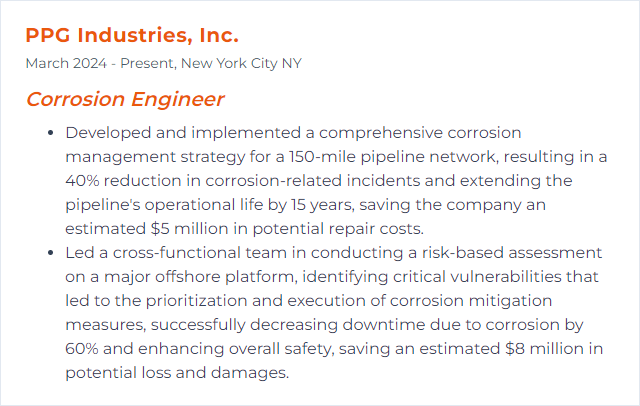
12. Pipeline Integrity
Pipeline integrity safeguards the fitness-for-service of pipelines by preventing, detecting, and managing corrosion and other degradation threats. Keep product in, hazards out.
Why It's Important
Public safety, environmental protection, and operational continuity hinge on it. Corrosion control is central to that promise.
How to Improve Pipeline Integrity Skills
Prevent first: Apply coatings and cathodic protection correctly. Use inhibitors where appropriate and verify effectiveness.
Inspect wisely: Inline inspection (MFL, UT), direct assessment, and targeted digs validate condition and growth rates.
Monitor continuously: Deploy probes, coupons, CP surveys, and chemistry tracking to catch shifts early.
Manage data: Use integrity management systems to integrate inspection, monitoring, defects, repairs, and risk into one living plan.
Follow standards and regulations: Conform to API, ASTM, and applicable regulatory rules. Document decisions and keep traceability tight.
How to Display Pipeline Integrity Skills on Your Resume

